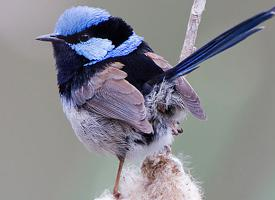
Description de l'animal
The Superb fairywren (Malurus cyaneus), often admired for its striking appearance and vivacious personality, is a small, dynamic passerine bird native to southeastern Australia. This species, belonging to the Maluridae family, is renowned for its vibrant coloration and complex social behavior, making it a subject of fascination among bird enthusiasts and researchers alike.Characterized by its diminutive size, the Superb fairywren typically measures between 14 to 16 cm in length, including its long, cocked tail that contributes significantly to its length. The males in breeding plumage are particularly eye-catching with their bright sky-blue crown, ear coverts, and upper back. The vivid blue is contrasted sharply against their black and grey wings, back, and tail, with a striking black band running through the eyes and around the back of the neck. Their underparts are a lighter grey or white, creating a striking visual contrast. Outside the breeding season, the males molt into a more subdued plumage that resembles the females', which are predominantly brown above with a reddish area around the eye and a buff-white underbelly. This cryptic coloration helps them blend into their surroundings, providing protection against predators.
The Superb fairywren inhabits a range of environments including woodlands, forests, scrublands, and even urban gardens, showing a remarkable adaptability. They are predominantly ground foragers, their diet consisting mainly of insects, spiders, and other small arthropods. This diet is supplemented occasionally by seeds, which they forage for among the leaf litter and undergrowth.
One of the most intriguing aspects of the Superb fairywren's biology is its complex social structure. They live in cooperative breeding groups consisting of a dominant breeding pair and several helper birds, which are often previous offspring of the dominant pair. These helpers assist in raising the young, including feeding and defending the nest. This social system is thought to increase the survival rate of the offspring and is a key area of interest for behavioral ecologists.
Reproduction in the Superb fairywren involves a variety of mating systems, ranging from monogamy to promiscuity. While there is a bonded pair within the group, both males and females may mate with multiple partners. The females are responsible for building the nest, which is a dome-shaped structure hidden in dense vegetation. They lay two to four eggs per clutch, which are incubated primarily by the female but with assistance from the helper birds in feeding and nest defense once the chicks hatch.
The Superb fairywren's song is another captivating feature, with the males singing intricate melodies to defend their territory and attract mates. Their calls are a common and delightful sound in their habitats, adding an auditory charm to their visual appeal.
Despite facing threats from habitat destruction and predation by introduced species such as cats and foxes, the Superb fairywren has maintained a stable population across its range. Conservation efforts and the adaptability of the species have helped ensure its persistence in both wild and modified landscapes.
In summary, the Superb fairywren, with its dazzling plumage, intricate social structures, and engaging behaviors, is a remarkable example of Australia's avian biodiversity. Its presence enriches the ecosystems it inhabits, making it a cherished species among birdwatchers and conservationists.
Carte de répartition

Nouvelles photos d'animaux
Top 10 des animaux
- Dolphin gull (Leucophaeus scoresbii)
- Diana monkey (Cercopithecus diana)
- Moustached guenon (Cercopithecus cephus)
- Galápagos tortoise (Geochelone nigra complex)
- Japanese macaque (Macaca fuscata)
- Stone loach (Barbatula barbatula)
- Russian tortoise (Testudo horsfieldii)
- Greek tortoise (Testudo graeca)
- Common flying dragon (Draco volans)
- Vendace (Coregonus albula)